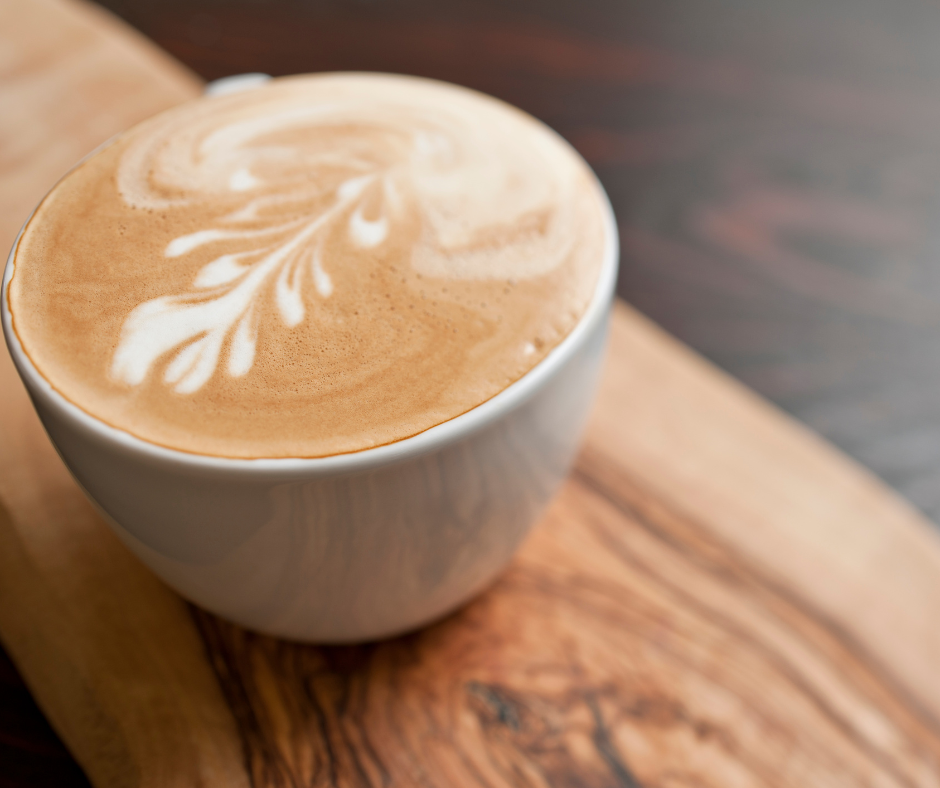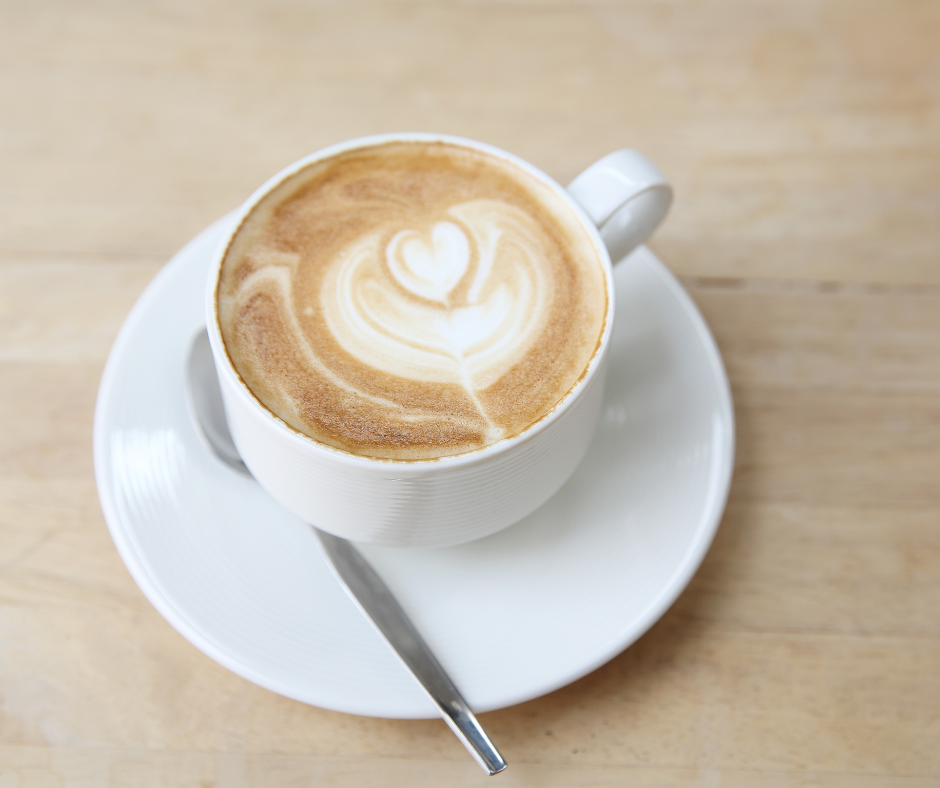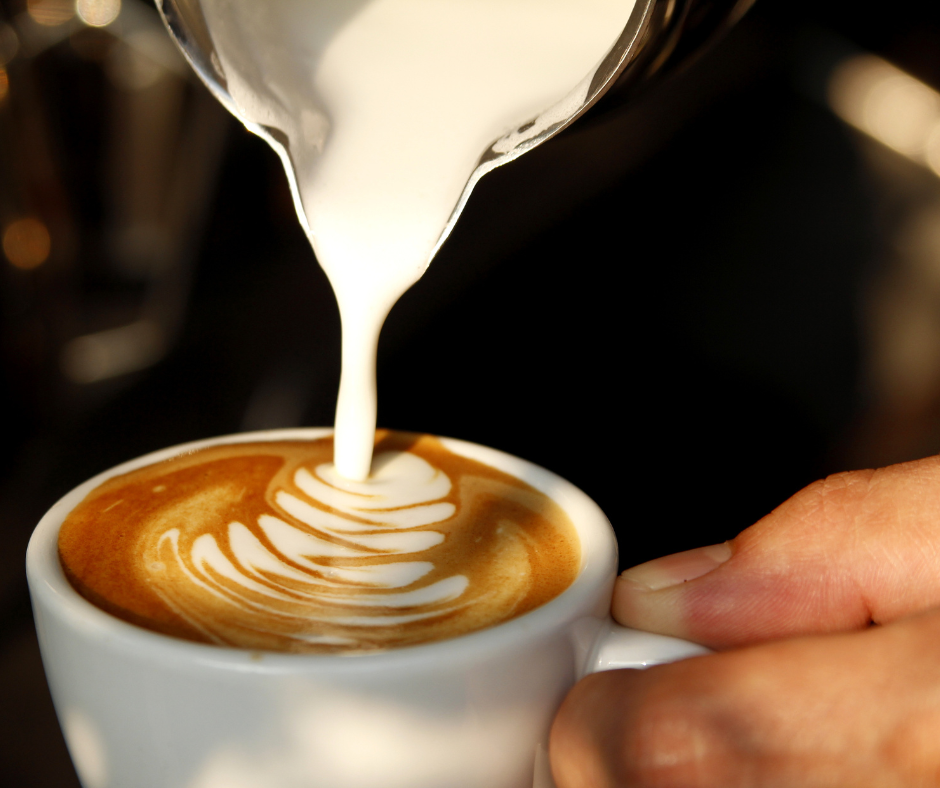Introduction
Two classics stand out regarding espresso-based drinks: the flat white and the latte. These beverages are beloved by coffee enthusiasts worldwide, but what exactly sets them apart? Let’s dive in and explore the differences when comparing Flat White vs. Latte.
Brief Explanation Of Flat White And Latte As Espresso-based Drinks
The flat white originated in Australia and New Zealand and is known for its strong espresso flavor and creamy, velvety milk texture. It is made with microfoam milk, which gives it a smooth consistency. On the other hand, the latte has its roots in Italy and combines espresso and steamed milk, topped with a layer of foam. It offers a milder coffee taste compared to the flat white.
Importance Of Understanding The Differences Between The Two
Understanding the differences when you compare Flat White and Latte can help coffee lovers make informed choices about their preferred coffee drink. The variations in milk type, frothiness, flavor, and caffeine content make each beverage unique. Whether you prefer a stronger espresso flavor or a creamier, milder taste, knowing the distinctions between these two classics allows you to enjoy your favorite cup of joe to the fullest.
So next time you’re at your local café or brewing coffee at home, consider whether you’re in the mood for a bold flat white or a more subtle latte. Explore each drink’s nuances and discover which suits your taste buds best. Cheers to indulging in your favorite espresso-based classic!
Origins And History
Origin Of Flat White In Australia And New Zealand
The flat white is a beloved espresso-based coffee drink in Australia and New Zealand. While there is some debate about its exact origin, both countries claim to be the birthplace of this delicious beverage.
According to popular belief, the flat white emerged in the 1980s as a response to the demand for a strong coffee with a velvety texture. It was created by combining two-thirds espresso with one-third microfoam milk. The result is a smooth and creamy coffee experience showcasing the espresso’s richness.
Historical Background Of Latte In Italy
In contrast, the latte has its roots in Italy, known as caffè latte. “latte” translates to “milk coffee,” which accurately describes the drink’s composition of espresso and steamed milk.
The latte has a longer history, dating back to the 17th-century Italian coffeehouses. Patrons would indulge in large quantities of milk with a shot of coffee, creating a creamy and satisfying beverage. Over time, the latte evolved into the popular drink we know today, with a balance of espresso and steamed milk topped with a small layer of foamed milk.
Both the flat white and latte offer unique flavor profiles and textures, making them beloved choices among coffee enthusiasts worldwide. Whether you prefer the robust and velvety experience of a flat white or the creamy and indulgent taste of a latte, these espresso-based classics are sure to satisfy your caffeine cravings.
By understanding the origins and history of these drinks, you can appreciate the cultural influences that have shaped their popularity. Regardless of which one you choose, the flat white and latte provide delightful options for enjoying your daily dose of caffeine.
Flat White vs Latte: Ingredients And Preparation
Two classics stand out regarding espresso-based beverages: the flat white and the latte. While these drinks may seem similar at first glance, there are key differences in the ingredients and preparation of Flat White vs. Latte.
Detailed Description Of The Ingredients Used In Flat White And Latte
A flat white is typically made with a double shot of espresso and steamed whole milk. The milk is aerated to create a microfoam consistency, which gives the drink its smooth texture. The foam bubbles in a flat white are small, resulting in a velvety mouthfeel.
On the other hand, a latte is made with a single or double shot of espresso and steamed milk. Unlike a flat white, the milk in a latte is not as aerated, resulting in a creamier texture. A layer of milk foam is added to the drink to enhance its visual appeal.
Step-by-step Process Of Making Both Drinks
Making a flat white involves pulling a double shot of espresso and steaming the milk to create microfoam. The foam is then poured over the espresso shot, resulting in a balanced flavor that showcases the richness of the coffee.
For a latte, the process begins by pulling a single or double shot of espresso. The milk is then steamed to create a creamy texture, with a layer of foam added on top. The espresso shot is poured into a cup, followed by steamed milk and a dollop of foam.
In conclusion, while the flat white and latte are delicious espresso-based drinks, their ingredients and preparation methods differ. Whether you prefer the smoothness of a flat white or the creaminess of a latte, each offers its unique flavor experience.
Flat White vs Latte: Taste And Flavor Profiles
When comparing two classic espresso-based drinks, Flat White vs. Latte, one key aspect to consider is their taste and flavor profiles. While both beverages contain espresso and steamed milk, some differences set them apart.
Examination Of The Taste Differences Between Flat White And Latte
The flat white offers a stronger espresso flavor due to its smaller size and the use of microfoam milk. This results in a more robust and sharper taste that coffee lovers craving a bolder profile may prefer. On the other hand, the latte leans towards a milder, creamier taste. The foam layer on top and the larger serving size create a smoother and more balanced coffee experience.
Comparison Of The Flavor Profiles, Including Sweetness And Intensity
In terms of flavor profiles, the flat white characteristically stands out with its rich espresso taste. The lower milk-to-coffee ratio allows for a more pronounced coffee flavor for those seeking a stronger caffeine kick. Meanwhile, the latte imparts a somewhat sweeter taste due to the higher milk content. The foam adds an extra element of creaminess that complements the espresso, resulting in a more indulgent and less intense flavor experience.
Ultimately, the choice between a flat white and a latte comes from personal preference. Whether you enjoy a bold and strong coffee or prefer a milder, milkier taste, these classic espresso-based beverages offer something for everyone. Understanding their taste and flavor profiles lets you decide which one best suits your preferences. So why not indulge in both and savor the unique nuances each has to offer?
Flat White vs Latte: Milk Texture And Foam
Regarding espresso-based classics, few beverages can rival the popularity of the flat white and latte. While they may appear similar, key differences set them apart when comparing Flat White vs. Latte, particularly in milk texture and foam.
Discussion On The Milk Used In Flat White And Latte
In a flat white, microfoam milk takes center stage. This milk is steamed and aerated to create a thick and velvety texture. The result is a smooth, creamy mouthfeel that perfectly complements the strong espresso flavor. On the other hand, lattes can be made with any milk and tend to have a milkier taste compared to flat whites.
Analysis Of The Foam Texture And Thickness In Both Drinks
Regarding foam, flat whites have a thinner layer of microfoam on top, about ¼ inch in thickness. This provides a creamier and richer experience for the palate. In contrast, lattes have a slightly thicker layer of foam, about ⅜ inch, resulting in a more frothy texture.
The difference in milk texture and foam thickness contributes to the overall taste experience of each drink. Flat whites offer a stronger coffee flavor with a smoother finish, while lattes provide a milder taste with a lighter and airier mouthfeel.
In conclusion, while flat whites and lattes both offer an enjoyable espresso-based experience, their differences in milk texture and foam showcase their distinct characteristics. Whether you prefer the velvety richness of microfoam or the milky indulgence of frothy milk, these classic beverages have something unique to offer coffee lovers.
Flat White vs. Latte: Caffeine Content
When it comes to choosing between a Flat White and a Latte, one important factor to consider is the caffeine content. Both these espresso-based classics provide a good kick of energy, but the levels of caffeine may differ.
Explanation Of The Caffeine Content In Flat White And Latte
A Flat White typically contains two shots of espresso, which are known to have about 68mg of caffeine each. This means that a standard Flat White could provide approximately 136mg of caffeine in total. On the other hand, a Latte usually contains one shot of espresso, which also contains around 68mg of caffeine. However, it is worth noting that a Latte can also be made with two espresso shots, which would result in a higher caffeine content.
Factors Influencing The Caffeine Levels
The amount of caffeine in these drinks can also vary depending on factors such as the number of espresso shots used and the serving size. While a Flat White is typically served in a smaller cup (around 165ml), a Latte is presented in larger cups (approximately 240ml). This difference in serving size and the milk-to-coffee ratio contributes to the distinction in strength and flavor between the two drinks.
In summary, both Flat White and Latte can provide you with the energy boost you need, thanks to their espresso base. However, if you prefer a slightly stronger coffee flavor with potentially higher caffeine content, Flat White might be your go-to choice. If you prefer a milder taste and are looking for a larger serving size, the latte could be more suitable for your preferences.
Flat White vs Latte: Serving Size And Presentation
When it comes to coffee, the serving size and presentation can play a big role in the overall experience of enjoying a cup of joe. In the case of Flat White vs. Latte, there are some key differences to be aware of.
Comparison Of The Cups And Sizes Typically Used For Flat White And Latte
A flat white is traditionally served in a smaller cup, usually around 165ml. This smaller size allows for a more concentrated flavor and a stronger espresso taste. The smaller cup also helps showcase the smooth and velvety texture of the microfoam milk, characteristic of a flat white.
On the other hand, a latte is typically served in a larger cup, approximately 240ml. The larger size allows for more milk to be added, resulting in a creamier and smoother coffee taste. The larger cup also provides more room for latte art, which has become a popular trend among coffee enthusiasts.
Importance Of Serving Size In The Overall Coffee Experience
The serving size not only affects the flavor profile of the coffee but also influences how it is enjoyed. A smaller cup like the one used for flat white encourages sipping slowly and savoring every sip, while a larger cup like the one used for latte allows for a more leisurely drinking experience.
Furthermore, the presentation of the coffee can also contribute to the overall enjoyment. Latte art, created by skillfully pouring steamed milk onto the espresso, adds an aesthetic appeal to the drink and enhances the overall experience.
In conclusion, while both flat white and latte are espresso-based classics, they differ in serving size, cup choice, and presentation. These differences can have an impact on the flavor, texture, and overall enjoyment of the coffee. So, next time you order your favorite espresso-based drink, take note of the serving size and presentation, as they can make a difference in your coffee experience.
Flat White vs. Latte: Customization Options
There is more than meets the eye when it comes to espresso-based classics like the flat white and latte. These drinks offer a world of possibilities for customization, allowing individuals to tailor their coffee experience to their unique tastes and preferences.
Exploration Of The Different Variations And Customizations Available For Flat White And Latte
The flat white and latte serve as the perfect canvases for exploring various flavor combinations. The options are endless, from alternative milk such as oat, almond, or coconut milk to flavored syrups like vanilla, caramel, or hazelnut. These additions can enhance or complement the rich flavors of the espresso base, making each sip a delightful experience.
Examples Of Alternative Milks, Flavors, And Latte Art
For those looking to further personalize their coffee, latte art provides an aesthetically pleasing touch. Skilled baristas can create intricate designs on the surface of the drink using steamed milk. From simple hearts and rosettas to more elaborate patterns like swans or tulips, latte art adds an element of visual appeal.
Additionally, alternative kinds of milk have gained popularity among coffee enthusiasts due to dietary preferences or lactose intolerance. These kinds of milk offer a unique flavor profile and can bring a creamy texture to the drink without compromising on taste.
With so many customization options, coffee lovers can make their flat white or latte their own. Whether it’s experimenting with different milk choices, adding a splash of flavor with syrup, or admiring a beautifully crafted latte art design, these customization possibilities contribute to the ever-evolving coffee culture.
So, if you’re looking to elevate your coffee experience and make it truly yours, don’t hesitate to explore the exciting world of customization options available for flat whites and lattes. Your taste buds will thank you.
FAQ about Flat White vs Latte: Comparing Two Espresso-Based Classics
Q: What is the main difference between a flat white and a latte?
A: The main difference lies in the ratio of milk to espresso. A flat white has less milk than a latte, resulting in a stronger coffee taste. On the other hand, the latte has a larger quantity of steamed milk, making it creamier and milder in flavor.
Q: Are there any differences in the foam used in a flat white and a latte?
A: Yes, there are differences in the foam. The foam is thinner and silkier in a flat white than a latte. The flat white foam is achieved through specific pouring and blending techniques.
Q: Can different types of milk be used in a flat white and a latte?
A: Flat whites typically use finely textured and velvety microfoam milk. Lattes, conversely, can use any milk – from dairy to alternative milk options like almond or soy milk.
Q: Which of the two espresso-based drinks has a stronger coffee flavor?
A: The flat white is known for having a stronger coffee taste due to its higher concentration of coffee. With its larger milk-to-coffee ratio, the latte offers a more subdued coffee flavor.
Q: Are there any regional variations in the preparation of flat whites and lattes?
A: Yes, different countries and regions around the world have their own interpretations of flat whites and lattes. These interpretations may result in slight variations in the ingredients used and the overall flavor profile of the drinks.
Q: Which drink is recommended for those looking for a creamier and milder flavor?
A: A latte would be better if you prefer a creamier and mellow flavor. A latte’s larger amount of steamed milk contributes to its creamy texture and mild taste.
Q: How does a flat white differ from a latte in terms of caffeine content?
A: Both the flat white and the latte use the same amount of espresso, so the caffeine content remains the same. The difference in taste comes from the milk-to-espresso ratio and the foam texture rather than the caffeine content.
Q: What is the ratio of coffee to milk in a flat white and a latte?
A: A flat white has a higher coffee concentration than milk, typically using a 1:2 ratio of espresso to milk. Conversely, a latte features a 1:2 ratio of espresso to milk, resulting in a more balanced and milkier taste.
Conclusion
Now you should know the comparison of Flat White vs. Latte. Both the Flat White and the Latte are popular espresso-based drinks that offer unique flavors and experiences. The Flat White stands out with its stronger espresso taste and velvety texture, thanks to the use of micro foam milk. On the other hand, the latte offers a creamier and milder coffee taste, with a layer of froth on top.
Summary Of The Key Differences Between Flat White And Latte
- Milk Type: Flat Whites require microfoam milk, while lattes can be made with any milk.
- Frothiness: Flat Whites have a subtle ¼-inch microfoam layer, while lattes have a medium ⅜-inch frothy texture.
- Flavor: Flat Whites have a stronger espresso taste and are more milk-forward, while lattes are slightly sweeter and less intense.
- Caffeine Content: Flat Whites usually contain two shots of espresso, totaling around 136mg of caffeine, while lattes typically have one shot but can vary between 68-136mg depending on size.
Personal Preference And Final Thoughts On Choosing Between The Two
When it comes to choosing between a Flat White and a Latte, it ultimately comes down to personal preference. Flat White might be the perfect choice if you enjoy a strong coffee flavor with a creamy mouthfeel. On the other hand, if you prefer a milder and milkier taste, the latte would be more suitable.
No matter which one you choose, the Flat White and the latte offer delightful caffeine boosts and are well-loved by coffee enthusiasts worldwide. So savor your favorite espresso-based classic, and enjoy every sip!

Deb Carlson at Crosslake Coffee: Join Deb at Crosslake Coffee for a delightful blend of community, caffeine, and creativity. Discover the cozy ambiance and warm hospitality that make this local coffee shop a beloved gathering spot. From expertly crafted espresso drinks to mouthwatering pastries, Deb invites you to savor every sip and bite. Stay connected with the latest updates on specials, events, and live music performances by following Deb Carlson at Crosslake Coffee on social media. Embrace the vibrant online community and share your love for great coffee and good company with fellow enthusiasts. Don’t miss out on a moment of the Crosslake Coffee experience – connect with Deb on social media today.



